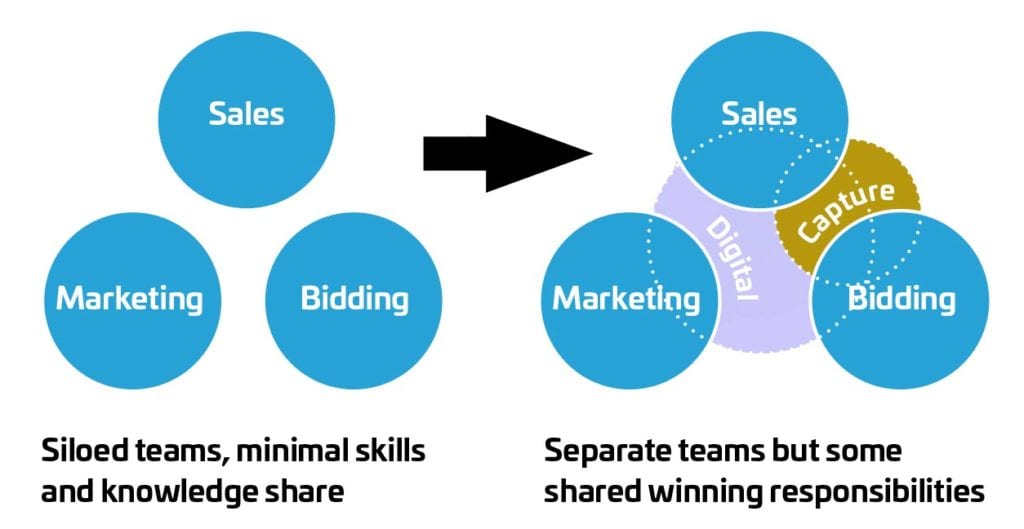
We were already seeing some changes in buying and selling before the pandemic hit: more decision makers, later market engagement, less time to respond and so on. Nothing new there. But things have changed over the pandemic. These changes are nicely summarised by data shown in a recent McKinsey survey:
- 70%-80% of B2B (busines to business) decision makers prefer remote human interactions
- Only 20% of buyers hope to return to in-person sales meetings post-pandemic
- 15% of buyers are spending over $1m digitally today – i.e. without any F2F (face to face) interaction
- Digital selling is as, or more, effective in terms of reaching and servicing customers (UK same, US/Brazil + 20%, India +38%)
- Consumers’ loyalty is diminishing; they are changing supplier more often. There’s a risk that this trend moves into B2B and B2G (business to government) environments.
Moving forward, the most effective organisations will be the ones who are able to bridge the silos between their own sales, marketing and bidding teams – where Bidding = Capture + Proposals + Pitching. The APMP’s focus on capture and its move into digital marketing (as evidenced in recent conferences) demonstrates how some of the gaps can be bridged with new approaches and practices, as shown below:

New virtual and digitally-enabled capability and associated approaches will drive the capture process and invigorate traditional proposal and pitch capabilities. Here are three key things that organisations should be working on to be successful as we enter the post-lockdown pandemic period.
1. Are your retention processes good enough?
Assume your competitors will be smarter with their approaches and are getting their message to your existing customer in new and innovative digital ways. Test your current approach to retention. Ask yourselves:
- Is your organisation as sticky as possible with your customer?
- Are your account management processes geared up for proactively retaining customers?
- Are you going beyond the SLA reporting, calculating and sharing the real value you are delivering?
- Are you building and maintaining relationships with all of the people who make buying decisions? This is often not exploited in all industries, especially where the deals are typically project-based.
- Do you have a structured process for renewing? Remember over 75% of buyers would seriously consider retaining an incumbent if they received a compelling offer.
- Could you protect 75% of your existing B2B customers without them going to market?
2. What’s your organisation’s perception in your marketplace?
Organisations have been countering the lowering levels of customer loyalty by promoting the good things they are doing and showing leadership during the challenging times. For example, Bank of America promised not to make job cuts during the pandemic and Starbucks committed to give free coffee to frontline health workers. So, think…
- Is your company talking about what you are doing or did during the pandemic?
- Is this a strength or a weakness versus your competitors?
- What do your customers now see when they look at your organisation? This may change how you approach bidding for work as previous assumptions on customer perception may have changed.
Three other predictions:
- Organisations will need to be more agile moving forward, as changes to customer and market demands will happen quicker
- All organisations will be looking for help being more digital and data savvy
- Cutting costs will remain critical for organisations – but it’s critical they don’t cut things that will devalue their brand
For bidders this means you need to find ways to help your customers and prospects achieve savings whilst protecting and enhancing their most valuable attributes. If you can help them be more flexible, provide digital assets and analytical tools and skills, then you’ll also be hitting an important hot button.
3. Are your bidding capabilities adapting fast enough?
The more successful bidding organisations are likely to focus on chasing fewer opportunities, going at each qualified opportunity earlier and executing them better and smarter. They’ll target winning by creating customer demand and have strategies that start with a goal of winning proactively (i.e. avoiding procurement and competition). How does this compare to your current approach?
Ask yourselves these five things:
- Can you call upon resources and expertise to create targeted digital campaigns that engage the people you want to connect to?
- Are you effective at identifying and working with coaches within the organisations that you want to win work with?
- Do you have the expertise to create the need for your customer to change, using storytelling techniques and consulting strategies to influence and persuade them?
- Are you maximising the impact of every customer interaction by using the latest communication and virtual pitching techniques?
- Do your capture plans include planning to get your customer’s procurement teams on side at the right time?
Many of you will recognise the trends and challenges that I’ve mentioned. Over 80% of the participants in the McKinsey report I referenced earlier believe that the changes will endure, so it’s up to you to determine whether you are geared up to handle them. Only by challenging your organisation’s current approach now, can you be sure that you can maximise the opportunity to win as we move forward in the new post-pandemic world.
This article was written by Graham Ablett.
Graham helps clients to win specific opportunities as well as implementing effective and efficient proposal processes. He is a former board member of APMP in the UK, holding APMP Professional status, and is an APMP Approved Trainer.

